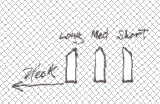 Jimmy's Setup Page
Jimmy's Setup Page
 Jimmy's Setup Page
Jimmy's Setup Page
![]()
Even if you don't feel qualified to set up your own guitar, you can at least check it to see if it needs some help. You will need a steel ruler that measures in 64ths, a thin guitar pick, and your guitar with a fresh set of strings on it, tuned correctly, or at least the way you usually tune it. If you have a capo keep it handy, but don't go out and buy one, you can do OK without it.
The first thing we're going to do is check the neck for the proper amount of relief, or bow. That's right, it's supposed to be bowed, but only a little! Fret each string at the 1st fret and the last fret clear of the body, and check for any gap between the string and the 5th or 7th fret. There should be a little but not so much that a thin pick won't "stick" there! (Note: You can use the capo to hold the strings down at the 1st fret, otherwise borrow a third hand from a friend or loved one!)
The above check will reveal one of three things (kinda like Goldilocks!?!), just the right relief, too little relief, or too much! If it's just right HOORAY! On to the next check! But if it's not perfect, something needs to be done about it for the rest of the set up to be valid. If you've never adjusted a truss-rod, and your guitar is a valuable one, now may be the time to seek professional help. If you want to try, PLEASE TAKE IT EASY! Replacing a truss-rod is EXPEN$IVE, and time consuming! Too little relief means the rod could be too tight, and needs to be loosened. This is usually easy! Too much relief can mean the rod is too loose and needs to be tighter. This can be tricky! In either case, the first thing you need to do is locate the truss-rod-nut, and a wrench or screwdriver that fits it. Then, with the strings very loose, bow the neck back slightly to take pressure off the rod, and loosen, or tighten as needed about a quarter turn. Then tune up, and re-check for relief. Repeat as necessary, but if you think you're getting close to breaking the truss-rod STOP! (Note: A loud "SNAP!" when you first move the rod does not necessarily mean you've broken the rod, they are often stuck and make this sound when they first break free!)
When you're satisfied that the relief is right, it's time to check the string height at the nut, unless your guitar has a "zero-fret" (a fret about 1/16", to 1/8" from the nut). In that case it can be assumed to be OK, if it's a pretty good guitar to begin with! Fret the strings at the third fret (use the capo if you have it), and observe the string height above the first fret. The strings should almost touch the first fret, much higher, and it will be hard to play. Any lower, and it will rattle on open notes! This is the primary thing that determines how your guitar will play in the first few positions, and it also has an effect on whether the guitar plays in tune on chords that use open notes. If you have to press down too hard, it's the equivalent of a string bend, making the 3rd string sharp on an E chord, the 2nd sharp on a C chord etc! Sound familiar? If you don't have the little files needed, don't try to adjust the notches in the nut. Pros who have the tools still foul this part up more than any other! Buy it done if you have to, but check the work, and don't settle for a sloppy job here, it's too critical! One other thing, there's no need for much (if any) nut sticking out above the string. In fact, any extra makes it more likely that the nut will break, so have the repair person cut it down to the minimum necessary to keep the strings where they belong!
Once the nut is OK, it's time to take a look at the bridge. Here's where things start to vary according to the kind of guitar you have, with most acoustics having apparently non-adjustable bridges, and most electrics having enough adjustments to pretty much insure that they will be OUT of adjustment! Lets cover string height first. Different kinds of guitars require different string heights. Acoustics will need a higher action because you pick 'em harder. Electrics can usually run their strings lower since more volume can be had from the amp, so you don't hit 'em as hard. String height is measured at the 12th fret, 1st and 6th strings respectively. Here's a chart of some typical guitars.
![]()
![]()
These numbers are from a mid-'70s Gibson owner's manual except for the Strat numbers, which are (I think) from a Guitar Player article from around the same time. They are in no way official, but they are time-tested, having served me well for 20+ years! Consider them a starting point. Any decent guitar should play OK when adjusted like this. If not, something is WRONG!
If your guitar can be adjusted to the above specs, do so, and then thoroughly play-test looking in particular for buzzy notes, or notes that cut out on string bends. Many recently built acoustics have a problem around the 10th fret, many Strats, especially 3-Bolt Strats from the '70s seem to have a problem around the 7th, to 12th frets. If it flunks the test you have to find out why, if it passes, it's off to Intonation - Land!
Do not even think of adjusting the intonation if your strings have more than 4 hours use on them!
If your pickups are adjusted as close to the strings as you can get them, adjust the pickups before attempting to adjust the intonation! This is especially true of guitars with Alnico-Magnet, Single-Coil pickups in the neck, or middle positions ( Strats, Teles & Clones Thereof )! See diagrams!
You have two kinds of strings on your guitar, plain, and wound. In each group, the thinnest one should be the shortest one, the fattest, the longest. So on an electric with a plain-third set, the first string is the shortest, the second & fourth next, followed by the third & fifth, and the sixth string is the longest. On a guitar with a wound third, the third string should be shorter than the second, almost as short as the first! See diagrams! To check the intonation, play a harmonic (chime) on the string at the 12th fret, and compare with the fretted note at the 12th fret using a tuner, or your ear. They should be the same, try it several times if necessary, but if they are not the same, the bridge must be adjusted to SHORTEN the string if the fretted note is too low, or to LENGTHEN the string if the fretted note is too high! Note that the fretted note is the one that's wrong if they're different, and the only one affected by the adjustment in any case! If you cannot get a clean, clear fretted note on the bass string(s) on an electric, if you almost seem to be getting two notes at once, THE PICKUPS ARE TOO CLOSE TO THE STRINGS and magnet-pull is affecting the string motion! (Sometimes called Strat-itus, because it was first seen on Strats, later on Strat derivative guitars.)
![]()
So called "non-adjustable" acoustic bridges can be adjusted!

You just slant the top of the bridge saddle with a small file!
The bridge below has the YELLOW part slanted to make the 2nd string longer! Many new guitars come this way, as it helps with the usual wound-third string sets found on most acoustic guitars.

![]()
Adjusting Strat-Style Pickups

The pickups on Stratocasters, and stratocopies (unlike most guitars), cannot be simply adjusted for the best sound, and even string balance. This is because their strong magnets will affect the motion of the bass strings unless the Neck, and Middle pickups are adjusted lower than would otherwise be ideal!
After you are satisfied with your string height, fret the first string at the LAST fret, and adjust all three pickups so they are 2/32" (1/16") from the string. Then fret the sixth string at the LAST fret, and adjust the bass end of the pickups as shown above, with the Neck pickup 4/32" (1/8") away, the Bridge pickup 2/32" (1/16") away, and the middle pickup half-way in between at 3/32". I usually just adjust the Neck, and Bridge pickups, and then lay my steel ruler across 'em both, and bring the Middle pickup up to the ruler.
Good Luck, and Play LOUD! Jim Stevens
![]()
Questions, or comments? |
Go to Our Home Page? |
Go to Ayers Music's Site |
See our pages on AOL? |
